Investing in one of the best car power inverters is also investing in convenience and safety. Ever been in a tight situation when you need some electricity? Ever worked outside with no sockets around, and you really need the power for your power tools? Well, as it turns out, there is a solution to that, if your car is nearby, that is. The solution lies in car power inverters – handy little devices that transform your vehicle into a powerhouse.
There can be a lot of situations that a power supply can enhance or even save the day. Campers and tailgaters use power inverters as a source, among other known solutions. Not to mention that we use electrical devices more and more by the day. You can also take a look at our best choices in the car power inverter reviews section. Let’s dig in!
See The Quick Comparison Chart
Benefits of Car Power Inverters
Some upsides of owning a car power inverter are obvious instantaneously. Just by reading how these devices work and how much they deliver, you can probably see a benefit or two by yourself. To be honest, the number of things you can achieve by having clean AC current on-demand without a grid close by is more than we have time to talk about. So, here are some pure benefits of having a car power inverter inside your vehicle:
1. Keep Your Devices Alive on the Road
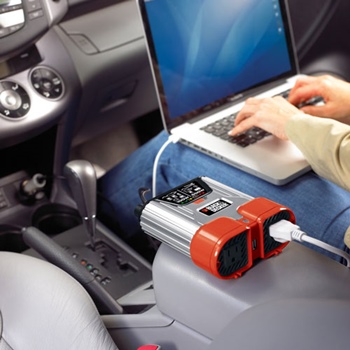 The very first benefit is the most popular one with people who travel a lot for business purposes. Nowadays, being connected and having a smartphone nearby at all times is paramount. A trustworthy car power inverter will enable you to work from remote locations without worrying about the “low battery” notification sounds all the time. Every type of handheld or lap gadget is supported, even by the smaller cigarette lighter car power inverters. This feature is a lifesaver, especially if you are traveling with kids.
The very first benefit is the most popular one with people who travel a lot for business purposes. Nowadays, being connected and having a smartphone nearby at all times is paramount. A trustworthy car power inverter will enable you to work from remote locations without worrying about the “low battery” notification sounds all the time. Every type of handheld or lap gadget is supported, even by the smaller cigarette lighter car power inverters. This feature is a lifesaver, especially if you are traveling with kids.
2. Cleaner Energy – Safer Gadgets
One excellent feature of car power inverters is the quality of the current they output. Every modern car power inverter has something called a sine wave modifier. This piece of the inverter has the task of rectifying and “ironing” the current that was modified from DC to AC, making it sine wave. Sine wave electricity is known for being extra-helpful with operating delicate and sensitive electronics. Some experts even suggest that, if we charged our devices on a sine wave at home (using an inverter), the devices would last longer. It is a matter of safety and durability, that’s all.
3. Camping Without Worries
One of the practical benefits of owning a car power inverter is having a stable source of electricity everywhere you go. This includes camping and tailgating as well. We know that camping is all about that survival without having access to electricity, but there are some exceptions where electric current is needed:
- Emergency – no matter if you have a radio or you want o use your phone as an emergency communication device, you will need power. Having a working car power inverter can be a literal lifesaver.
- Bug repellents – there is no excursion to the wild without various bugs, including the ones we all hate – mosquitos. Campers with access to electricity in the wild learned that a bug buzzer or repellent could enhance the camping experience by a large margin.
- Food storage and prep – just imagine freshly brewed coffee in the middle of nowhere. Or, how about some hot tea in the middle of a freezing cold forest. Also, there are some freeze boxes that can use the power supplied by a car power inverter.
4. Bring Your Power Tools Along!
Lastly, the benefit we all love for the sheer utility is nonother than – power tools anywhere you go. Drills, saws, chainsaws, compressors, you name it. A direct contact car power inverter can enable all of that. Imagine having to fix something on the road, or, if you are a professional, having access to your tools no matter where you are. DIYers and all sorts of construction workers keep a car power inverter ready for situations like these.
Best Car Power Inverters Comparison Chart
| PRODUCT | DETAILS | ||
|---|---|---|---|
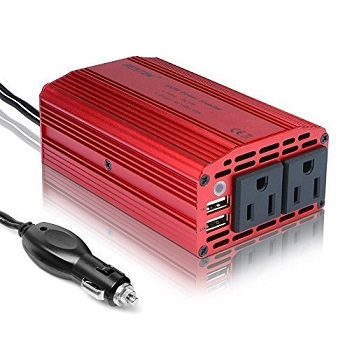 | BESTEK 300W Car Inverter with 4.2A Dual USB Car Adapter |
| View On Amazon |
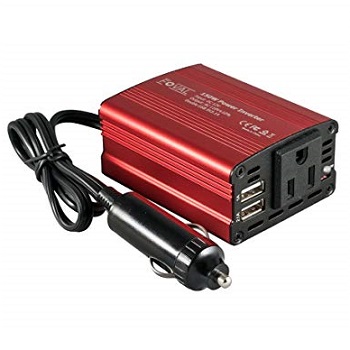 | Foval 150W Car Power Inverter DC 12V to 110V |
| View On Amazon |
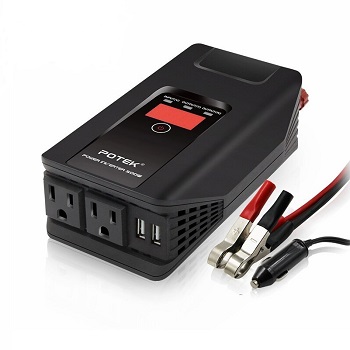 | POTEK 500W Power Inverter with Digital Display Dual AC Outlets |
| View On Amazon |
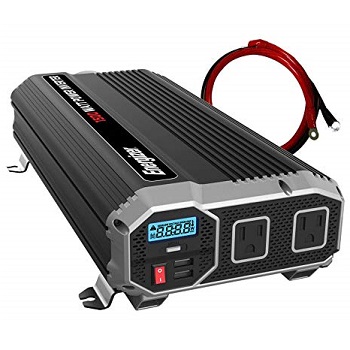 | Energizer 1500 Watt 12V Power Inverter with 2 USB Ports |
| View On Amazon |
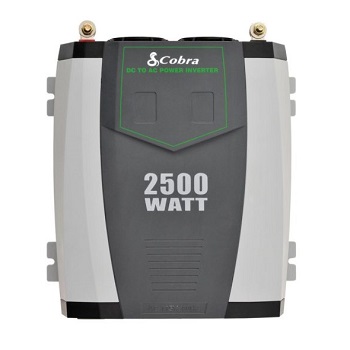 | Cobra CPI2590 Gray 2500W 2.1A USB Power Inverter |
| View On Amazon |
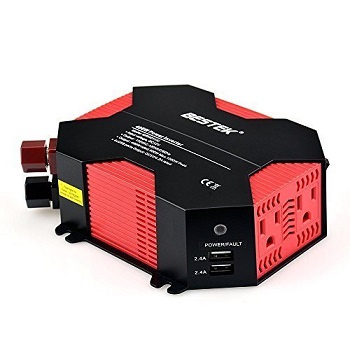 | BESTEK 400W Car Power Inverter with 5A 4 USB Charging Ports |
| View On Amazon |
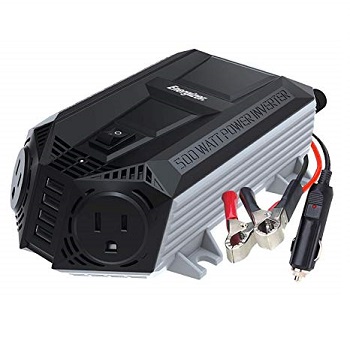 | ENERGIZER 500 Watt Power Inverter USB Charging Ports |
| View On Amazon |
Car Power Inverter Reviews
1. BESTEK 300W Car Inverter with 4.2A Dual USB Car Adapter
 BESTEK, as a manufacturer, has its hat in the game for some time now. Using the knowledge and experience they’ve gathered over the years, they decided to make car power inverters for all types of drivers and users in general. This particular car power inverter is among the smaller from the series, which doesn’t mean that it doesn’t have features to offer. On the contrary.
BESTEK, as a manufacturer, has its hat in the game for some time now. Using the knowledge and experience they’ve gathered over the years, they decided to make car power inverters for all types of drivers and users in general. This particular car power inverter is among the smaller from the series, which doesn’t mean that it doesn’t have features to offer. On the contrary.
The very first thing you will notice is the incredible portability. The compact design is made for people who prefer to have access to a battery charger at all times when it comes to tech devices and gadgets. The car power inverter has a 300 W of working power, which is not that big, but it is enough to power more than one device at a time. The housing has two coolers, one on each side. When it comes to connection, we are talking about a cigarette lighter 12 V connector. On the front panel, besides a led power indicator, you can see two regular and two USB outlets. This car power inverter with USB port is protected by a 40-amp fuse.
Pros
- Super portable and easy to carry, ideal for traveling
- Has a great cooling system for safety reasons, as well as a 40-amp circuit breaker
- Next to a couple of standard outlets, there are additional two USB charging ports
Cons
- The car power inverter starts heating up at 70W, but the cooling system handles it with ease
- This car power inverter is on the weaker side when it comes to wattage, dedicated for consumer electronics and laptops
2. Foval 150W Car Power Inverter DC 12V to 110V
 If you are looking for a power source to accompany you in your travels, this Foval car power inverter might be the right one for you. Though weaker in wattage, it is dedicated to supporting your smart devices like phones and tablets, with an occasional TV or a laptop. It is pretty small, weighing only 8 oz., believe it or not. When it comes to the connection type, we are talking about a standard 12 V DC cigarette lighter connection.
If you are looking for a power source to accompany you in your travels, this Foval car power inverter might be the right one for you. Though weaker in wattage, it is dedicated to supporting your smart devices like phones and tablets, with an occasional TV or a laptop. It is pretty small, weighing only 8 oz., believe it or not. When it comes to the connection type, we are talking about a standard 12 V DC cigarette lighter connection.
In terms of wattage and working output power, this particular car power inverter unit provides 150 W of clean 110 V AC current. On the front panel, there is an output indicator light. Just because it is small in size doesn’t mean that it cannot deliver. For this reason alone, the manufacturer decided to put extra layers of short-circuit protection and a system that protects from overloading, underloading, and higher temperatures. Due to the portability of this car power inverter, you get only one standard outlet, with two USB ports on the side.
Pros
- Amazingly portable car power inverter that weighs around 8 oz.
- Several layers of protection, including overvoltage, under load and heat protection
- The shell is made of aluminum which gives the car power inverter extra protection from physical damage
Cons
- It provides 150 W of working power only. Suitable form TVs, laptops and phones, but nothing too strong
- Has only one standard 110V outlet, which is understandable due to the size of the box
3. POTEK 500W Power Inverter with Digital Display Dual AC Outlets
 Here we have a hybrid car power inverter that can be both plugged in the 12 V cigarette lighter port and directly connected to the battery. This POTEK has a combination of features and price that can be helpful to people on the road that do not have huge power needs and requirements. It is a portable power inverter for car, with the downside of being made mainly out of plastics.
Here we have a hybrid car power inverter that can be both plugged in the 12 V cigarette lighter port and directly connected to the battery. This POTEK has a combination of features and price that can be helpful to people on the road that do not have huge power needs and requirements. It is a portable power inverter for car, with the downside of being made mainly out of plastics.
The working wattage depends on the power route. If you connect it directly to a car battery, you get 500 W of power. If you decide to go portable and connect it to the cigarette lighter port, the maximum working power clocks at 150 W. The manufacturer provided necessary connectors, including both the clamps and the cigarette lighter connector. On the top side, there is a small backlit LCD screen to show you the input and output voltage and output wattage. The car battery power inverter has two regular and two USB outlets.
Pros
- Compact design that still has two regular AC outlets, next to two USB ports
- Can be hooked both directly to the battery and through a cigarette lighter port
- The car power inverter has a backlit LCD to give you live statistics of the current
Cons
- Has too many plastic parts, which are firm nonetheless
- The provided clamps are of thin gauge wire. Getting a separate set that fits is the safest bet
4. Energizer 1500 Watt 12V Power Inverter with 2 USB Ports
 If you ever used portable energy sources, you have probably heard of the legendary Energizer. They went all out to develop this monster of a car power inverter. It is bigger than an average car power inverter, yes, but it delivers incredibly high results. The box is made of aluminum, making it extra-durable. On the bottom side, you can see dedicated holes that act as a mount if you wish to attach the car power inverter to the underside of the car’s hood.
If you ever used portable energy sources, you have probably heard of the legendary Energizer. They went all out to develop this monster of a car power inverter. It is bigger than an average car power inverter, yes, but it delivers incredibly high results. The box is made of aluminum, making it extra-durable. On the bottom side, you can see dedicated holes that act as a mount if you wish to attach the car power inverter to the underside of the car’s hood.
The working power of this unit is 1500 W, which is more than enough for all kinds of on-road demands. House appliances work like a charm on this car power inverter, except if we are talking about stoves and large fridges. On the front panel, there are two regular outlets and two USB ports for smart devices. There is also a backlit LCD display that can give you better insight into input and output voltage, output wattage, and battery level.
Pros
- 1500 Watts of working power makes this car power inverter a powerful ally in every sense
- A backlit LCD display that gives you all sorts of info
- A couple of larger fans are built into the shell for faster and more efficient cooling.
Cons
- This car power inverter must be connected directly to the car battery
- The unit comes with a heftier price, but makes it up in performance
5. Cobra CPI2590 Gray 2500W 2.1A USB Power Inverter
 The Cobra sounds like an intimidating name for a car power inverter. Well, as it turns out, it actually is a small monster. It is quite chunky for a device of this type, but it brings a punch so powerful that it makes you forget about the bulkier body. It is made of sturdy metal materials, with a couple of plastic hatches on the side panels.
The Cobra sounds like an intimidating name for a car power inverter. Well, as it turns out, it actually is a small monster. It is quite chunky for a device of this type, but it brings a punch so powerful that it makes you forget about the bulkier body. It is made of sturdy metal materials, with a couple of plastic hatches on the side panels.
So, what makes this a beast? The working power of this Cobra car power inverter is an astonishing 2500 W. This means that you can power a fridge outside if you so wish. It goes without saying that this car power inverter needs to be attached directly to the battery. On the back panel, there are 2 active cooling fans, and there is one on the front. Also, on the front, you can find a set of three standard 120 V AC outlets, a single USB port, a backlit LCD for statistics, and a remote control input. On the outer rim of the body, there are carriers and holes to help you mount the car power inverter.
Pros
- Super powerful car power inverter with 2500 W of working power
- Has additional heat dissipation system and more fans than average
- This car power inverter can be connected to a remote-control unit
Cons
- This is an expensive car power inverter that delivers a whole bunch of power and protection
- Some users reported that the LCD has a larger than average error margin
6. BESTEK 400W Car Power Inverter with 5A 4 USB Charging Ports
 Here we have a somewhat futuristic-looking BESTEK car power inverter that can act as a hybrid when it comes to input. Regardless, it is still pretty portable and compact, and with the option to use it as a hybrid, you can surely find a place for this car power inverter. The shell is made mainly of aluminum and plastic and gas a slightly octagonal shape.
Here we have a somewhat futuristic-looking BESTEK car power inverter that can act as a hybrid when it comes to input. Regardless, it is still pretty portable and compact, and with the option to use it as a hybrid, you can surely find a place for this car power inverter. The shell is made mainly of aluminum and plastic and gas a slightly octagonal shape.
Now, this hybrid has the option to be connected directly and through the cigarette lighter port. If you decide to do it directly, the working power peaks at 400 W. On the other hand, if you want to have the power accessible while you drive, the maximum wattage clocks at 150 W. Both the cable and the clamps are provided by the manufacturer. On the front side, you can find two standard 110 V AC outlets, as well as two USB ports for gadgets and devices.
Pros
- Super-portable car power inverter that can accompany you everywhere you go
- Has the hybrid option of connection. 150 W in portable mode, and 400 W of power when connected directly to the car battery
- This car power inverter is modernly designed, which can be a must for younger users
Cons
- Not a particularly strong car power inverter with 400 W of max output
- The cables provided are a bit too thin, but they are well insulated nonetheless
7. ENERGIZER 500 Watt Power Inverter USB Charging Ports
 Energizer deals with everything that has to do with remote and portable energy. This car power inverter is made for people on the go and people who need to have a charging station for their devices at all times. The body is made of metal and plastics and is entirely black. This car power inverter model is a hybrid, so both connection types are fair game.
Energizer deals with everything that has to do with remote and portable energy. This car power inverter is made for people on the go and people who need to have a charging station for their devices at all times. The body is made of metal and plastics and is entirely black. This car power inverter model is a hybrid, so both connection types are fair game.
However, even though you can connect it directly to the car battery, this particular car power inverter can handle its full capacity of 500 W even when connected to the cigarette lighter port. This means that you can do practically connect it any way you want – from using it as a portable inside the car to hardwiring it under the hood. When it comes to the cooling process, this unit has an ultra-silent thermal fan that keeps it nice and cool under operation. There is a total of six outlets – two are standard 120 V AC sockets, and four are USB ports. Both clamps and cigarette lighter connector is provided by the manufacturer.
Pros
- A hybrid car power inverter that can deliver 500 W of working power even when connected through the cigarette lighter port
- Has a pair of regular outlets and four USB ports
- The cooling system is efficient and ultra-quiet
Cons
- For a 500 W car power inverter, this model is a bit pricier
- The all-black design makes it hard to spot the socket in the dark
What Is a Car Power Inverter?
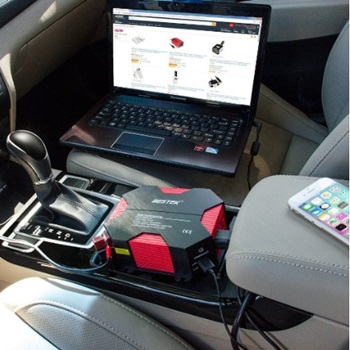 In essence, a car power inverter is a relatively small device that uses electronics and engineering for a single task – inverting power. Now, most devices and gadgets nowadays use alternating current (AC for short) as the main power source. No matter if we are talking about phones, laptops, stoves, or coffee machines, AC is needed. As a matter of fact, every socket in your home is most certainly giving out AC current, which has a voltage of 110-120 V, or sometimes even 220-240 V.
In essence, a car power inverter is a relatively small device that uses electronics and engineering for a single task – inverting power. Now, most devices and gadgets nowadays use alternating current (AC for short) as the main power source. No matter if we are talking about phones, laptops, stoves, or coffee machines, AC is needed. As a matter of fact, every socket in your home is most certainly giving out AC current, which has a voltage of 110-120 V, or sometimes even 220-240 V.
A power inverter is a piece of equipment that uses your car’s battery, and we all know the voltage of car batteries – 12 V of direct current (DC for short). The cases in which electronic devices use DC are by far rarer than devices that use AC. For example, some of the best car tire inflators can use the cigarette lighter port to help you inflate the tires. So, the car power inverter presents a huge help on the road if you need electricity for a device, piece of machinery, or maybe to charge up your gadgets and devices. Some car power inverters even have dedicated 5 V USB sockets to help with the smaller electronics charging.
All in all, car power converters are a great helping hand no matter what you do. A large number of drivers decide to have one in the back of the car’s trunk or even installed under the hood. We sincerely think that car power inverters deserve more attention, hence this whole guide’s existence.
How Do Car Power Inverters Work?
Without getting into the physics of car power inverters too deep, we would like to approach the basics of how inverters work shortly. In the section above, we mentioned that the main purpose of a car power inverter is to transform DC to AC. For the sake of not staying stuck in this guide for a month, we will not get into the systems behind the DC to AC conversion. Instead, we would like to take you through the essential parts, their functionalities, and generally talk about how car power inverters work. Through a simple end-to-end process, we can see what happens and enable a better insight into these useful utility machines.
1. Input
The very first thing you do when you want to use a car power inverter is enabling access to the 12 V DC port. When it comes to the input criteria, car power inverters are separated into two types – direct and inner connection (more about that later). Once you have connected the car power inverter to the car’s battery, regardless of the source, its input terminal is transferring 12 V DC current, letting it enter the device. The connection from the car battery to the car power inverter is usually made through clamp cables (black and red) or with a double-ended cigarette lighter connector.
2. Inversion
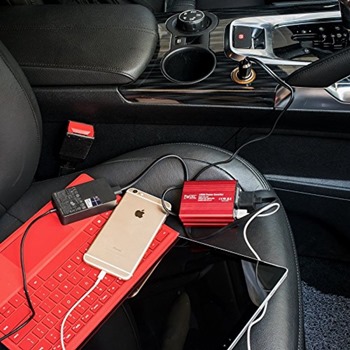 Now that the 12 V Dc current has entered the car power inverter, it is time to give it a voltage boost and transform it into standard 120 V AC. This is done through some marvelous engineering and physics wiring systems, which we are not going to spend time on right now. So, the car power inverter boosts the current-voltage to 120 V, yes, but it also provides a power rating. This power rating will limit the number and size of devices, tools, and appliances you want to plug in.
Now that the 12 V Dc current has entered the car power inverter, it is time to give it a voltage boost and transform it into standard 120 V AC. This is done through some marvelous engineering and physics wiring systems, which we are not going to spend time on right now. So, the car power inverter boosts the current-voltage to 120 V, yes, but it also provides a power rating. This power rating will limit the number and size of devices, tools, and appliances you want to plug in.
3. Monitoring and Cooling
Some car power inverter models have voltage monitoring. This is usually done through a simple LCD or an LED display. The screen, if there is one, will most likely be placed on the upper side of the car power inverter, so it can be visible from different angles. Some screens even have a backlight, just in case you want to work in a low-visibility environment. The screen usually shows you the input and the output voltage, as well as the current load on the inverter, shown in Watts (W for short).
Power inverting is a hot business, especially if you load power tools or heating appliances on the car power inverter. That is why manufacturers decided to put an active cooler fan inside the car power inverter’s body. Some inverters even have two or more, depending on their load capacity. Just remember not to obstruct the airflow to the fans.
4. Output
Finally, after the current has been changed and monitored, it is ready for use. The most common case when it comes to the car power inverter sockets is – two standard three-pronged 120 V AC sockets. These are made to look like and have the same functionality as the sockets we all have at home.
Now, considering that we all have gadgets in the form of tablets, phones, laptops, etc. a lot of car power inverter manufacturers decided to put USB ports on their inverters. This system eliminates the need for an extension cord, or additional charger adapters, making the car power inverter more stable and durable.
Types of Car Power Inverters
Due to their exceptional versatility and the overall demand for these units, car power inverters come in one of two types. Even though the types do not differ much when it comes to operation, they are two different worlds when it comes to wattage ratings. As you might have guessed from the section above, the two types are:
- Direct car power inverters
- Indirect car power inverter, also known as cigarette lighter or inner inverters
1. Direct Car Power Inverter
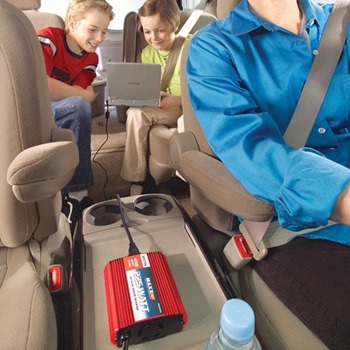 Often considered the older brother, the direct car power inverter is a device you need if your power needs exceed 500W. As the name suggests, the direct connectors are attached directly to the 12 V DC car battery. This is achieved through clamps, similar to the car jumper cables. Once you connect the clamps to the car power inverter’s terminal, you can start using the AC immediately.
Often considered the older brother, the direct car power inverter is a device you need if your power needs exceed 500W. As the name suggests, the direct connectors are attached directly to the 12 V DC car battery. This is achieved through clamps, similar to the car jumper cables. Once you connect the clamps to the car power inverter’s terminal, you can start using the AC immediately.
However, direct connect car power inverters come with a few minor drawbacks. First of all, inverters like this need a bit of space around while working. The thing is – cooling is an essential part of the whole current inversion process because the car power inverter box gets pretty hot pretty quickly. Another thing to consider is the size of the direct connect car power inverters. They are bulkier, yes, but they also come with some sort of mounting system, just in case you wish to attach them to the car’s infrastructure under the hood. In most cases, this means that you won’t be able to use the car power inverter while driving. It is mainly designed to output large wattage for more serious machines and power tools.
2. Inner Car Power Inverter
The counterpart to the large and bulky direct connect is the inner car power inverter. It is smaller, in some model’s cases significantly smaller, and it comes with some portability features that the direct connect units do not have. For starters, this type of car power inverter goes inside the vehicle, not under the hood. This means that you have the option to use AC electricity while you drive. Charging gadgets, phones, and laptops are all on the table during the ride. These devices take the input DC current through the cigarette lighter port, or other 12 V DC port inside the car (which is quite rare nowadays).
But, as every smaller piece of electronics goes, this one also has some power drawbacks. Car power inverters like these have significantly lower wattage ratings compared to direct connect models. They usually cap at 500 W, which is enough load for smaller electronics and lighting, but not a lot of power tools or appliances.
Car Power Inverter Buying Guide
There – all the basics about car power inverters, how they operate, and how you can benefit from getting one. Now, let’s move on to the practical advice on how to pick a car power inverter for yourself, having the needs and requirements in mind. If you are interested in car tech, equipment, and useful tools to enhance your driving experience, feel free to check out our library of knowledge about cars. Let’s dig in!
1. Type
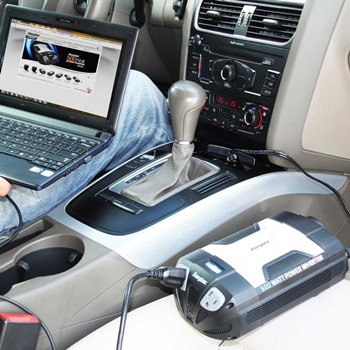 The very first thing you need to decide is whether you want to get a direct connect car power inverter or an inner connection type. The truth is, even though they do the same thing, these devices are quite different when we talk about performance and accessibility. The larger, direct connect type will provide you with a higher wattage rating, meaning more devices can be powered at the same time. On the other hand, you will have to get out of the car to use it. Not to mention the cooling procedures and mounting.
The very first thing you need to decide is whether you want to get a direct connect car power inverter or an inner connection type. The truth is, even though they do the same thing, these devices are quite different when we talk about performance and accessibility. The larger, direct connect type will provide you with a higher wattage rating, meaning more devices can be powered at the same time. On the other hand, you will have to get out of the car to use it. Not to mention the cooling procedures and mounting.
With the smaller, cigarette lighter, version, you will get less wattage (fewer devices powered at the same time), but you can use the car power inverter while driving.
When it comes to this decision, it mainly depends on your power requirements and general habits you have with electronics. This brings us to the next, very important topic.
2. Predict the Usage
Making a decision about power sources is always about calculations. For example, if you intend to charge your phone and laptop every now and again, you do not need a 1,5 KW direct connect monster of a car power inverter. The key is in planning. Put all your portable devices and machines on a piece of paper, find out how much power they require, and make a rank list.
Now, we know that this might sound like too much. Of course, we are not asking of you to exactly predict every device you will be using in the years to come. Just make a ballpark estimate on how much power your devices and tools generally use, and how often.
3. Outlets
This should come as a no brainer, but people tend to forget and oversee the benefit of adequate power sockets. If you want to have a well-performing USB charger for your vehicle, then a smaller cigarette lighter type of car power inverter will do just fine. On the other hand, having a three-pronged socket is more than welcome in any situation. Most car power inverters have two regular 120 V sockets and a couple of USB ports.
4. Build Quality and Cooling
Aim for the heavy-duty build. We are aware that this sounds like a blanket statement, especially with car-related gear, but it goes double for car power inverters. The way you wouldn’t get the cheapest brake pads for safety reasons – the same logic applies here. Get a car power inverter box with preferably metal casing. If you opt for a direct connect type, you should remember that these boxes go under the hood and need to be capable of taking a bumpy ride.
Additionally, always get a model with as many cooling fans as possible. We cannot stress this enough – car power inverters heat up strong and fast, and a little extra cooling on the side will not hurt. Some people even get helping external cooling fans. This goes especially to people that plan to use power tools with their car power inverters.
5. Additional Features
This category can mean a lot of things. However, there is a number of additional things you can get with your car power inverter that can help you with connecting, storage, safety, etc. Even though this should not be the deciding factor, it is always a good thing to have a nice bag to pack the cables and the car power inverter itself. Additionally, some car power inverter models come with an extra pair of cables and connectors. Another nice to have thing is a mounting rack. People who decide to attach the car power inverter under the hood benefit from mount-ready boxes the most.
6. Amp Breakers
Last but not least, we have a technical factor that can save you from short circuits, thus saving potential money lost on repairs and replacements. Every direct connect car power inverter has some sort of circuit breakers as a safety measure. While you will not see them in every small type, we suggest that you aim for models that have as many amp breakers as you can find. More is better and definitely safer.
How to Install and Use Car Power Inverters?
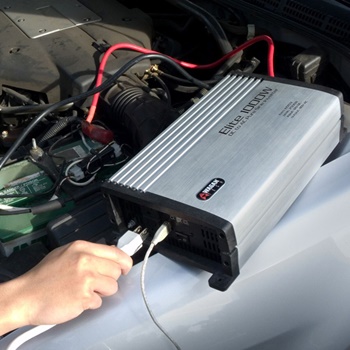 Installing a car power inverter is not that hard nor complicated. There are some tips and tricks we would like to share with you, though. Here is a step-by-step guide on how to install a car power inverter, with some extra tips on the side.
Installing a car power inverter is not that hard nor complicated. There are some tips and tricks we would like to share with you, though. Here is a step-by-step guide on how to install a car power inverter, with some extra tips on the side.
- Turn off your vehicle, especially if we are talking about direct connections between the car power inverter and the car battery.
- Connect the clamps or hooks to the car battery. In this case, you need to follow the color coding and connect positive to positive and negative to negative. The conventional color codes are red for the positive end and black for the negative. *If we are not talking about direct connect car power inverter, just plug the box into the cigarette lighter box.
- Once everything is connected (please practice extra caution, its electricity we’re meddling with), you can start the car power inverter. If there are indicators or displays, check for the input and output current status. Do not plug the devices and load the converter right away – give it a minute.
- Once you have confirmation that the car power inverter is working properly (you can hear the fans as well), you can start using it by plugging in the power-hungry devices.
- After you are done, unplug the charged devices first, turn the car power inverter box off, and detach it from the 12 V source.
FAQ About Car Power Inverters
1. Will using a car power inverter damage my car?
This is a fair question to ask. Meddling with car electronics can be a dangerous, and often a damaging task. However, when it comes to car power inverters, the risks of car damages are minimal. You see, the car power inverter is connected to the car battery only – it doesn’t interfere with the rest of the car electronics system. Your devices can demand different wattage ratings at the same time, but every car power inverter has modules inside that equalize that demand for the purpose of not creating a power surge or any other short-circuit related issue.
One thing that could happen, unfortunately, you can drain your car’s battery if you are not careful enough. No one likes to ask for jump-starting, which brings us to our next frequently asked question.
2. How do I make sure I don’t drain the car battery while using a car power inverter?
Car batteries, no matter how strong they look, are not suitable to play a constant, prolonged power source. Just leaving a car headlight on will drain the battery in no time, with LED headlights may be needing an extra hour or two. However, cars have a system that recharges the battery while the engine is working. It’s called the alternator. This piece of tech is in charge of recharging the car battery and keeping it in the best possible condition. Batteries degrade over time, yes, but they do so at a very slow rate.
So, if you want to keep your car battery fresh and ready to supply the power to the car power inverter, you need to start the car and let it idle. Even while idling, the rotations from the engine are recharging the battery through the alternator. It is true that the alternator does its work best while the car is moving, but even at idle state, you can get a charge, it just takes a bit more time.
3. Are my devices safe while charging on a car power inverter?
The short answer is – yes, your devices are safe charging on a car power inverter. However, if you are using a cigarette lighter type, you should be careful when the engine is exerting high RPMs. During highway rides, while you are speeding up, the car electronics system can give off a surge that is not that friendly to appliances.
So, to put thigs shortly – laptops, tablets, power banks, smartphones, and every device with similar power loads are safe. On the other hand, avoid using heavier appliances in the car while driving due to the risk of short-circuiting the appliance. Moderation is key, especially with inner type car power inverters.
Wrap Up
Everything you need to know about these ultra-useful devices is here, without getting too technical, that is. Having a reliable power source is a great commodity to have, and a lot of people’s jobs rely on it. Not to mention the benefit of having an emergency power source if something goes wrong on the road. Take your time and pick out the best car power inverter that can match your needs and requirements. It is not all about affordability. Modern car power inverters are affordable, but you need to know what you’re looking for. Also, take a look at our picks in the car power inverter reviews section and see for yourself.
We hope that we’ve managed to shed some light on this somewhat complex topic. Car gear and equipment is a topic that we could go on about for ages. Have fun with your new power source!
See also: jumper cable reviews – best xenon kits